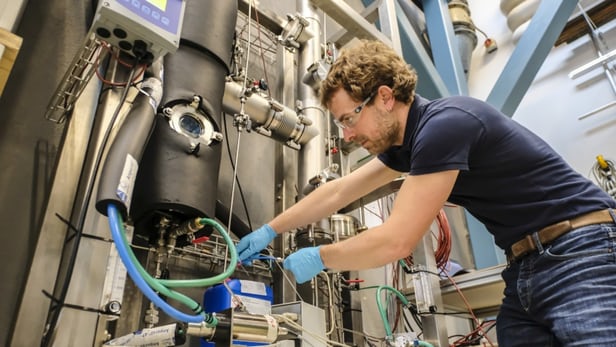Transitioning away from fossil fuels used for heating creates a sustainable environment, but it can be difficult for several people when turning up a thermostat on a gas or electric thermostat provides instant gratification and warmth. Convincing people to switch to more renewable resources can be challenging, but having simple and quick-to-use systems will encourage them to do so.

Swiss researchers working at EMPA (the Swiss Federal Laboratories for Materials Testing and Research) have developed a process that stores heat captured during the summer, which can be transported anywhere it’s needed and be used with the flick of a switch during winter. The system uses concentrated sodium hydroxide (NaOH) as the thermal storage medium and components to capture, convert, and release heat energy when needed.
When water is poured onto dry sodium hydroxide, an exothermic reaction occurs, causing the chemical energy found in the NaOH to be released as heat. NaOH is very hygroscopic, meaning it has a strong attraction for dragging in and holding water molecules from the surrounding environment. As a result, more water is produced from condensation and the vapor in the air and the sodium hydroxide solution is heated even further. Thus, larger amounts of heat can be freed from NaOH by adding more water.
If heat energy is mixed into a sodium hydroxide diluted with water, the moisture evaporates and the solution becomes more concentrated, thus storing the supplied energy. The mixture can be stored for several months or years until the heat is freed when the NaOH is exposed to water again. Additionally, the mixture can be transported to other tanks where heat energy is desired.
The storage medium is a liquid composed of a 50% NaOH solution that travels through a spiral pipe and soaks up water vapor along the way and then transfers the generated heat into the pipe. The heat can then radiate, convert, and conduct into the area that needs the warmth.
Throughout the process, the sodium hydroxide solution pours down the outside of the heat exchanger spiral, where it’s diluted approximately 30% inside the system, and the water temperature within the pipe rises to 50°C (122°F). The temperature is optimal for under-floor heating.
While it’s still in the prototype stage, EMPA is searching for commercial partners to help create a compact version of the system for household domestic use. EMPA’s heat storage device is one of three systems in the COMTES project, which is hoping to develop and demonstrate seasonal storage of solar thermal energy.
Source: New Atlas
Advertisement
Learn more about Electronic Products Magazine





